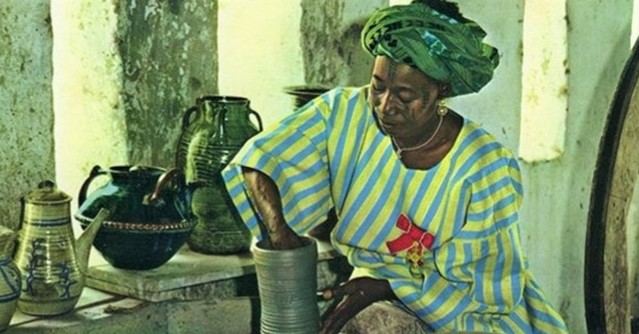I Imagine a young Ladi Kwali. Learning the coiling system from her Aunt, unknown to her that she would influence a modern form of the art. Hadiza Ladi Kwali was born to an extended family of female potters in the small village of Kwali, present Kwali Area Council of the Federal Capital Territory, in 1925 (Other historians indicate her date of birth is actually 1920). She grew up in a family that kept up with the folkloric female tradition of pottery making. Mallam Mekaniki Kyebese, Ladi Kwali’s younger brother, stated;
“even in the early years of pottery making, Ladi Kwali excelled in the crafts and her wares were often sold even before they were taken to the markets’.
During her first professional years, the traditional cultural environment moved her to produce pottery pieces that were influenced by the Gbagyi tradition and accentuated with personal idioms. Her approach to clay was echoed by mathematical undertones, made visible by the continuous display of symmetry.
RISE TO FAME.
Her talent was recognised early by the Emir of Abuja (now Suleja), Alhaji Suleiman Barau, who collected her pots for display in his palace where they caught the attention of the potter Michael Cardew (1901-1983) during his 1950 tour for his extensive report on pottery development for the Nigerian colonial government. After Mr Cardew founded the Pottery Training Centre (PTC) in Abuja in 1952, Ladi Kwali became its first female trainee in December 1954. She completed her training in January 1959 and was employed at the centre.
Although Mr. Cardew taught her wheel-throwing, Ladi Kwali used the centre’s stoneware clay to create pots using the traditional free-hand modelling technique in which she was adept. She decorated them with poetically incised lines rendered in bands that left ample space in-between for her rendition of schematised figures of scorpions, fishes, birds, snakes, chameleons, crocodiles and lizards.
At the centre, she learned wheel throwing, glazing, kiln firing, production of saggars, and the use of slip, eventually assuming the role of instructor. She made bowls with sgraffito decoration, which involved dipping vessels in red or white slip and then scratching the decoration through the slip to the underlying body, using a porcupine quill. The quintessential Ladi Kwali pot was coiled in a stoneware clay, decorated with lizard patterns and fired with a dark shiny glaze. For Western viewers and collectors, the dark glaze was a metaphor for the pots’ “Africanness.”
From her cultural tradition, where females were primarily responsible for pottery, Ladi Kwali’s ceramics became “art objects”. Ladi Kwali’s pots were featured in international exhibitions of Abuja pottery in 1958, 1959, and 1962, organised by Cardew. In 1961, Kwali gave demonstrations at the Royal College, Farnham, and Wenford Bridge in Great Britain. She also gave demonstrations in France and Germany over this period. In 1972, she toured America with Cardew. Her work was shown to great acclaim in London at the Berkeley Galleries. The Abuja Pottery was renamed the Ladi Kwali Pottery in the early 1980s.
INFLUENCE ON OTHER FEMALE POTTERS.
By the time Cardew left his post in 1965.The Centre had attracted four additional women from Gwari: Halima Audu, Lami Toto, Assibi Iddo, and Kande Ushafa These women worked together in one of the workshops, which they called Dakin Gwari (the Gwari room), to hand-build large water pots.
They would shape and scrape the insides of the pots with the shell of a snail, a hard seed pod or a calabash rind. Then, they adapted their traditional incised designs, by inlaying them with a white kaolin and feldspar slip, which would gravitate into the depressed decorations. After these pots were fired with a translucent celadon glaze, the areas with slip would appear pale green in contrast with the dark green or iron red stoneware body of the vessels. Because the hand-built, ornately decorated pots were glazed and fired in a high-temperature kiln, they represent an interesting hybrid of traditional Gwari and western studio pottery.
Women are largely involved in the traditional art of pottery making in Nigeria and in Northern Nigeria. This is not different. Although the use of pottery differs from tribe to tribe. Gbagyi women like Ladi Kwali are known to be the custodians of the traditional art form. As mentioned earlier. She learnt her skills from her Aunt and it was not strange to find women partake in the process where she is from.
The making of the art centre by Micheal Cardew brought attention to the Gabagyi’s culture of pottery. All these would not be possible if he had not seen Ladi Kwali’s works and invited her to the centre. Later on in 1990 6 years after the death of Ladi Kwali. The then first Lady of Nigeria, Mrs Mariam Badamasi Babbangida established the Ushafa pottery centre as one of her Pet projects to empower rural women in the area and promote the Gbagyi form of pottery.

Leave a Reply